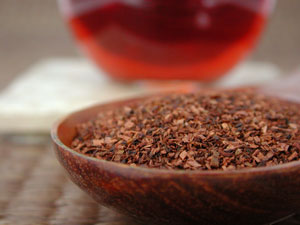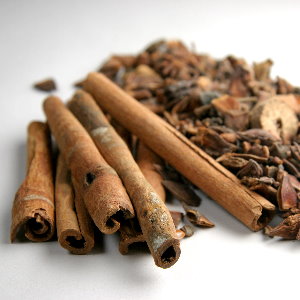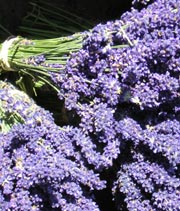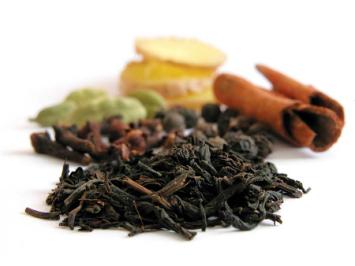
Red Tea, courtesy of Mountain Rose Herbs
In product descriptions in my Etsy shop, I often write about ingredients that act to “calm” the skin. What does that mean, exactly? For one thing, someone might turn to ingredients that calm the skin because she experiences redness, puffiness, dark circles, potentially inflammatory conditions such as rosacea or acne, and needs the harmonizing power of doubly calming & regenerative ingredients for more mature skin.
Some of the ingredients used in the skin care industry include those that contain ANTI-OXIDANTS, ESSENTIAL FATTY ACIDS (ESFs), and ANTI-INFLAMMATORY compounds. In fact, many of these ingredients contain all three qualities, as anti-oxidants and essential fatty acids both work to reduce inflammation, and certain extracts or oils contain both anti-oxidants and essential fatty acids.

Cinnamon
We can get these compounds in our diets, and certainly that is the best way to bring these nutrients to your skin, that great filtering organ that can benefit –or suffer from–whatever we put into our bodies. Antioxidants are found in colored fruits, leafy greens, and colorful vegetables, as well as green, white, and black tea, red (rooibos) tea, cinnamon, coffee, and black pepper. Essential Fatty Acids include Omega 3,6, & 9’s are found in fatty fish, flaxseed, and walnuts, among other sources. Dietwise, we get plenty of Omega 6 & 9’s regardless, so what you want to focus on are getting those Omega 3’s from good, fresh sources (i.e. keep your walnuts in the freezer to prevent rancidity). Anti-inflammatory qualities are found in superfruits like blueberry, mangosteen, goji berry (or chinese wolf berry/lyciium fruit), acai, and powerhouse herbs such as turmeric, lavender and chamomile. You can get a great solid blueberry extract at Herbalist & Alchemist. The benefit of these superfruits is that they contain both antioxidants AND anti-inflammatory compounds, as these qualities often come from the same source.

Blueberries
Anti-oxidants reduce free-radical damage and help repair the skin and protect it from long-term damage. In your skincare products, when you see extracts or oils from fruits & vegetables such as blueberry, carrot, or kelp, you know you’re getting something that is high in anti-oxidants. Extracts are usually alcohol “tinctures” which act to chemical extract these active compounds. You might see CO2 extracts, which can closely resemble the original plant, or alcohol extracts. It is preferable to have extracts made from grain alcohol instead of ethyl alcohol. Another type of extract can be created from glycerin, which adds additional moisture content to the product. Oils used in bath & beauty products can also be high in antioxidants, including carrot, coconut, and meadowfoam seed oil. These high anti-oxidant oils not only protect your skin but they prevent further damage. There are many herbs that are rich in anti-oxidants as well, including Tea leaf (black, white and green), Rooibos, Cinnamon, and Rosehips.
Essential Fatty Acids (ESFs) are usually found in oils that are rich in Omega 3, 6 & 9’s. Some of these oils include sunflower seed, safflower seed, rosehip seed, borage, evening primrose, camellia seed, sweet almond, and walnut oils among others. Borage oil is a fabulous source of the essential fatty acid gamma linolenic acid (GLA), and as the GLA of borage oil is 24% , it is actually the richest known source in the world. Amazingly, GLA is needed by the body to produce the anti-inflammatory protaglandins believed to strengthen cell membranes & combat diseases such as eczema, arthritis, and other inflammatory conditions. Essential Fatty Acids are superior moisture-grabbers. Research suggests that some of those with eczema or severely dry skin may have an ESF deficiency and would benefit from ESF-rich diet and skin care attention. Therefore, it is important for anyone with dry skin issues, especially dry, flaky and reddened skin to make sure they use products rich in ESFs both externally and internally.

Lavender
Some favorite anti-inflammatory herbs are Turmeric and Chamomile. Turmeric is the anti-inflammatory herb of choice in Ayurvedic medicine and is also high in anti-oxidants. Chamomile is another favorite anti-inflammatory that I often use in the treatment of skin conditions such as eczema, as it seems to have clinically proven benefits as great as that of topical steroids. Holy Basil, or Tulsi, my ‘herb of choice’ for 2010, also has mild anti-inflammatory qualities. Essential oils and distillates/ hydrosols, the by-product of steam distillation, can also contain potent anti-inflammatory qualities in skin care products. Helichrysum hydrosol and essential oil, for example, is a strong anti-inflammatory often called ‘Imortelle’ or ‘Everlasting’ because of its wonderful anti-inflammatory and regenerative properties. Lavender is another herb that is wonderful to use as an essential oil, distillate, or extract for its anti-inflammatory compounds, and its calming activity on the skin has been seen in individuals with rosacea and acne.
I hope that helps clear up a few questions! Are there ingredients that you’ve noted lately and have wondered about? If so, let me know!





 Posted by lilithsapothecary
Posted by lilithsapothecary 


